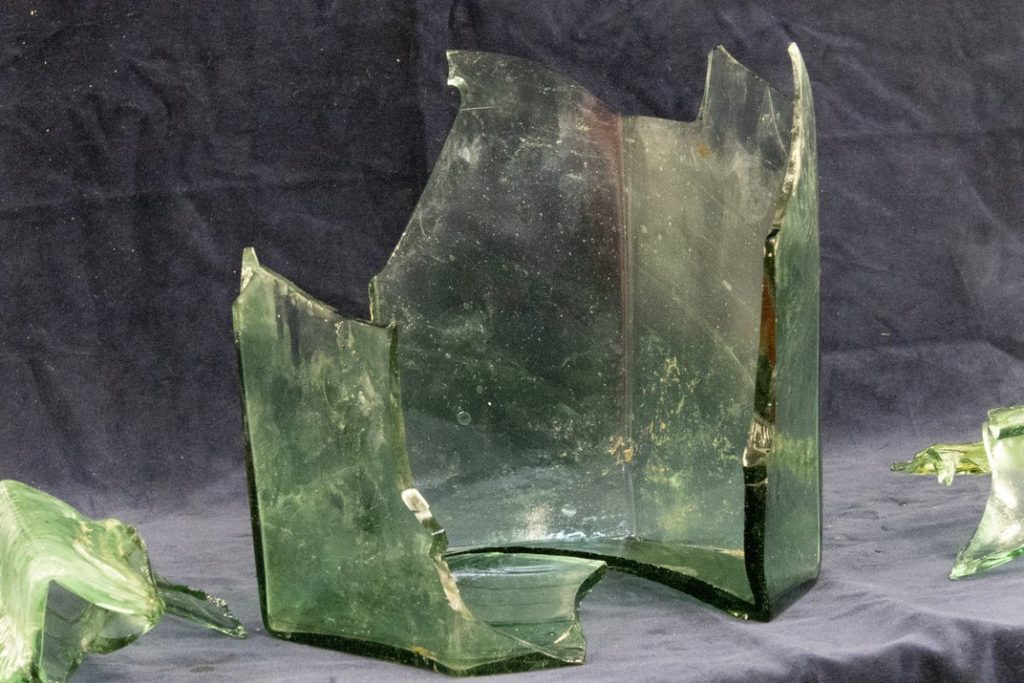
Excavators working at a site that will be part of the UK’s HS2 high-speed train system in Stoke Mandeville, Buckinghamshire made the discovery of their lives recently on the very last day of work, uncovering Roman statues that had once been part of a mausoleum there.
At the site, on which a Norman-era church was constructed, the statues of a man, woman and child lay buried for almost 2,000 years; they would have been lost forever if it hadn’t been for the excavations carried out as part of the controversial high-speed rail system.
Perhaps most amazing of all was the uncovering of a green glass jug which was in several pieces. Roman-era glass is rarely excavated in Britain because of its fragility, making the find all that more intriguing.
The site of St. Mary’s Church, built around the year 1080 and torn down in the middle of the twentieth century, earlier had been the site of a Roman-era mausoleum.
Roman statues and mausoleum atop Bronze Age burial mound complex
Archaeologists were stunned at what they called the “once-in-a-lifetime” find; previous discoveries uncovered due to the excavations for the HS2 project include the skeleton of a murder victim from the Iron Age and a hoard of coins that are 2,000 years old.
Lead archaeologist Rachel Wood told the press in a statement “For us to end the dig with these utterly astounding finds is beyond exciting.
“The statues are exceptionally well preserved, and you really get an impression of the people they depict—literally looking into the faces of the past is a unique experience.”
Located in rural Buckinghamshire, just northwest of London, the site also is home to remnants of a burial mound from the Bronze Age, according to a report from Smithsonian.
Wood and her team of archaeologists uncovered two complete stone busts of an adult man and woman, along with what they think is the statue of a head of a child. The heads, which fit perfectly atop matching torsos, had been buried alongside them; however there was no matching torso for the child.

The team of archaeologists exulted in the statement at the find of the statues, saying that their discovery was “uniquely remarkable.”
The history of the site apparently goes back to the Bronze Age in Britain, experts believe. Just outside Aylesbury, the current county seat of Buckinghamshire, a burial mound was constructed out of what may originally have been a natural mound. In Roman times, the mound was the site of a square-shaped mausoleum, leading to the burial of Roman Britons and the placement of the statuary.
Tragically, the mausoleum was destroyed during the creation of the Norman-era church, called St. Mary’s, hundreds of years later, atop it. It is unknown if the statues were vandalized at that time or had already fallen down over the centuries.
The excavations that were undertaken as part of the rail project also brought to life Roman cremation urns, along with painted wall plaster and roof tiles.
Archaeologist Wood emphasized that the hexagon-shaped glass jug is extraordinarily rare — adding that the only other example of a similar intact vessel, unearthed in Tunisia, is now part of the collection of the Metropolitan Museum of Art in New York City.
“Of course, it leads us to wonder what else might be buried beneath England’s medieval village churches,” she added in her statement about the find.
According to a BBC News report, the cemetery at St. Mary’s was in use for 900 years, with the last recorded burial in 1908. Abandoned in 1880, the church was demolished in 1966.
Now, restoration experts are cleaning the priceless Roman statues at a laboratory; they hope to find traces of pigments that may have once been used on the statues. The pieces will most likely be displayed at a local museum once all the work on them has been finished.
Wood stated jubilantly “This has truly been a once in a lifetime site, and we are all looking forward to hearing what more the specialists can tell us about these incredible statues and the history of the site before the construction of the Norman church.”
See all the latest news from Greece and the world at Greekreporter.com. Contact our newsroom to report an update or send your story, photos and videos. Follow GR on Google News and subscribe here to our daily email!



